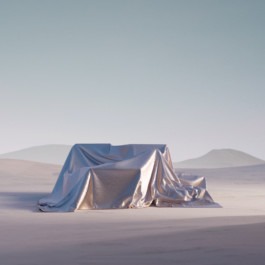



Deep Space Sofa, part of THE SHIPPING Collection by Andrés Reisinger
Interview
Andrés Reisinger, artist, creator, director and 3D visual designer
20 April 2021
COLLECTIBLE: You recently hit the news with your $450,000 sale of a collection of impossible furniture. This was sold during an online auction on NiftyGateAway under the title, ‘The Shipping’. You had been designing digital furniture for a while. Last year, at COLLECTIBLE, you exhibited the first insta-famous-turned-into-real-life-CGI-render-chair. Can you share a bit how you transitioned into selling works as NFTs?
Andrés Reisinger: It was a logical transition. I’ve been working with 3D for more than 10 years now and 3D manifests itself digitally. It is its natural habitat, so to say. Therefore transitioning to selling my work as digital assets using digital currencies made a lot of sense.
“It is between the physical and digital worlds that my practice is situated. I bridge the boundary in order to reveal the infinite possibilities of the digital.”
C: Far from rejecting the physical world, you speak about a "hybrid reality". You will produce a couple of pieces of furniture in real life and in collaboration with the buyer. Was it always the intention to make those impossible virtual furniture real? Isn't this something peculiar for NFTs? Are these pieces going to remain one-offs?
AR: Yes, that was always my intention and yes, those pieces are going to exist as unique pieces, there was never an intention to replicate them. It is between the physical and digital worlds that my practice is situated. I bridge the boundary in order to reveal the infinite possibilities of the digital. It’s true that this is not common for NFTs, and it was the first collection of art objects that crossed these boundaries. There’s one piece that doesn’t exist in any dimension yet so it is neither digital, nor physical, which is crossing yet another conceptual border!
C: There is a sudden fascination with NFTs and a lot of talk about how this will transform the art world and benefit artists. But for the design world, which is traditionally defined by functionality and answering needs, what do you think NFTs can bring to designers? Are there any cons you would anticipate for designers that they should be careful about?
AR: For artists, for example, it is generating a possibility to create a first-hand link and sell an artwork in digital form directly to a global audience of buyers without using an auction house or gallery. This allows them to keep a significantly greater portion of the profits they make from sales. Royalties can also be programmed into digital artwork so that the creator receives a percentage of sale profits each time their artwork is sold to a new owner. Everything has its pros and cons, naturally. I would only recommend staying open and agile as the technology is constantly evolving, and one should trim the sails to the wind, metaphorically speaking.
C: Something we hear less about is how NFTs and crypto-art are actually involving an enormous energy consumption and seem to generate an unreasonable ecological cost. What is your position on this?
AR: Calculating carbon footprint based on transaction count fundamentally misunderstands how Ethereum works. The blocks happen regardless of your transaction count. The ecological impact generated by NFTs is insignificant compared to the damage that the current banking system is causing to the environment. Every argument on this is based on a superficial perception of the way these processes are operating. This year, we are transitioning from POW to POS, which offer a solution to massive, decentralized transactions, with zero ecological cost.

The Custom Piece, part of THE SHIPPING Collection by Andrés Reisinger

Tangled Chair, part of THE SHIPPING Collection by Andrés Reisinger
About Andrés Reisinger
Creating at the intersection of art, design, and direction, Andrés Reisinger bridges the imagined and the tangible. Conceptual yet accessible, his immersive 3D visuals, otherworldly compositions, and experimental use of texture draws the realm of dreams close. Hailing from Buenos Aires and based in Barcelona, Reisinger applies over a decade’s worth of experience working with the likes of Apple, Microsoft, and Samsung to challenge the boundaries of diverse media. His progressive spatial experiences and hyped collectible pieces have earned him recognition in the Forbes 30 Under 30 Europe, ADC One Club Young Guns, and the AD100, among others.

Portrait of Andrés Reisinger.
About "The Shipping"
“The Shipping”, by Reisinger Andrés, is a collection that presents ten pieces of furniture. Five come with physical counterparts, but all ten can be implemented digitally in any open-world. They also come with the promise that they will be iterated on in the future to continue being open-world compatible. This is the next step in Andrés power to transport his viewers and represents a manifestation of a new hybrid reality. Andrés, together with his peers from Reisinger Studio, launched up its first 24-hour online auction, held on February 19, 2021, featuring designs from “The Shipping” collection which were revealed on the day of the auction.
Interview
Andrés Reisinger, artist, creator, director and 3D visual designer
20 April 2021

Deep Space Sofa, part of THE SHIPPING Collection by Andrés Reisinger
COLLECTIBLE: You recently hit the news with your $450,000 sale of a collection of impossible furniture. This was sold during an online auction on NiftyGateAway under the title, ‘The Shipping’. You had been designing digital furniture for a while. Last year, at COLLECTIBLE, you exhibited the first insta-famous-turned-into-real-life-CGI-render-chair. Can you share a bit how you transitioned into selling works as NFTs?
Andrés Reisinger: It was a logical transition. I’ve been working with 3D for more than 10 years now and 3D manifests itself digitally. It is its natural habitat, so to say. Therefore transitioning to selling my work as digital assets using digital currencies made a lot of sense.
“It is between the physical and digital worlds that my practice is situated. I bridge the boundary in order to reveal the infinite possibilities of the digital.”
C: Far from rejecting the physical world, you speak about a "hybrid reality". You will produce a couple of pieces of furniture in real life and in collaboration with the buyer. Was it always the intention to make those impossible virtual furniture real? Isn't this something peculiar for NFTs? Are these pieces going to remain one-offs?
AR: Yes, that was always my intention and yes, those pieces are going to exist as unique pieces, there was never an intention to replicate them. It is between the physical and digital worlds that my practice is situated. I bridge the boundary in order to reveal the infinite possibilities of the digital. It’s true that this is not common for NFTs, and it was the first collection of art objects that crossed these boundaries. There’s one piece that doesn’t exist in any dimension yet so it is neither digital, nor physical, which is crossing yet another conceptual border!
C: There is a sudden fascination with NFTs and a lot of talk about how this will transform the art world and benefit artists. But for the design world, which is traditionally defined by functionality and answering needs, what do you think NFTs can bring to designers? Are there any cons you would anticipate for designers that they should be careful about?
AR: For artists, for example, it is generating a possibility to create a first-hand link and sell an artwork in digital form directly to a global audience of buyers without using an auction house or gallery. This allows them to keep a significantly greater portion of the profits they make from sales. Royalties can also be programmed into digital artwork so that the creator receives a percentage of sale profits each time their artwork is sold to a new owner. Everything has its pros and cons, naturally. I would only recommend staying open and agile as the technology is constantly evolving, and one should trim the sails to the wind, metaphorically speaking.
C: Something we hear less about is how NFTs and crypto-art are actually involving an enormous energy consumption and seem to generate an unreasonable ecological cost. What is your position on this?
AR: Calculating carbon footprint based on transaction count fundamentally misunderstands how Ethereum works. The blocks happen regardless of your transaction count. The ecological impact generated by NFTs is insignificant compared to the damage that the current banking system is causing to the environment. Every argument on this is based on a superficial perception of the way these processes are operating. This year, we are transitioning from POW to POS, which offer a solution to massive, decentralized transactions, with zero ecological cost.

The Custom Piece, part of THE SHIPPING Collection by Andrés Reisinger

Tangled Chair, part of THE SHIPPING Collection by Andrés Reisinger
About Andrés Reisinger
Creating at the intersection of art, design, and direction, Andrés Reisinger bridges the imagined and the tangible. Conceptual yet accessible, his immersive 3D visuals, otherworldly compositions, and experimental use of texture draws the realm of dreams close. Hailing from Buenos Aires and based in Barcelona, Reisinger applies over a decade’s worth of experience working with the likes of Apple, Microsoft, and Samsung to challenge the boundaries of diverse media. His progressive spatial experiences and hyped collectible pieces have earned him recognition in the Forbes 30 Under 30 Europe, ADC One Club Young Guns, and the AD100, among others.

Portrait of Andrés Reisinger.
About "The Shipping"
“The Shipping”, by Reisinger Andrés, is a collection that presents ten pieces of furniture. Five come with physical counterparts, but all ten can be implemented digitally in any open-world. They also come with the promise that they will be iterated on in the future to continue being open-world compatible. This is the next step in Andrés power to transport his viewers and represents a manifestation of a new hybrid reality. Andrés, together with his peers from Reisinger Studio, launched up its first 24-hour online auction, held on February 19, 2021, featuring designs from “The Shipping” collection which were revealed on the day of the auction.
Contact
info@collectible.design
VIP PORTAL
EXHIBITOR PORTAL
PRIVACY POLICY
© 2025 Collectible
Contact
info@collectible.design
VIP PORTAL
EXHIBITOR PORTAL
PRIVACY POLICY
© 2025 Collectible